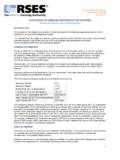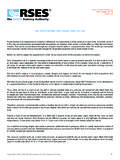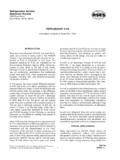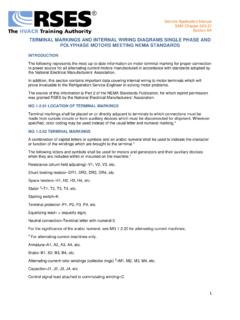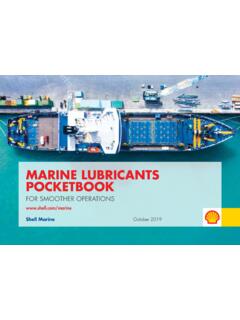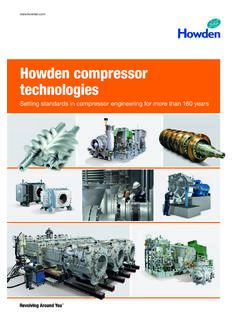Transcription of OPERATION OF AMMONIA REFRIGERATION SYSTEMS
1 Service Application Manual SAM Chapter 620-89 Section 1E OPERATION OF AMMONIA REFRIGERATION SYSTEMS International Institute of AMMONIA REFRIGERATION INTRODUCTION The purpose of this chapter is to provide a reference document containing suggested practices for the OPERATION of an AMMONIA REFRIGERATION system. It is intended that this chapter be used as a general reference source and that in all cases, recommended practices issued by equipment manufacturers and suppliers take precedence over these recommendations when they afford greater protection. GENERAL INFORMATION AMMONIA (NH3) at normal temperatures and pressures is a colorless gas made up of one part nitrogen and three parts hydrogen. It is lighter than air and has a sharp, pungent odor that serves as a warning of its presence. While AMMONIA is a relatively toxic substance, it is not a cumulative poison. It is highly soluble in water and forms a solution known as ammonium hydroxide (NH4OH) or aqua AMMONIA , commonly used as a household cleaner.
2 Commercially, AMMONIA is made by combining free nitrogen and hydrogen gases under high pressure and temperature in the presence of a catalyst. The process most commonly used is the Harber-Bosch method. Anhydrous AMMONIA is the liquid form of pure AMMONIA gas, technically water-free, and the substance used universally as an industrial refrigerant. The most important physical properties of anhydrous AMMONIA are: Molecular Symbol NH3 Molecular Weight Boiling Point (at one atmosphere) -28 F Freezing Point (at one atmosphere) F Latent Heat of Vaporization (@ 70 F) Btu/lbVapor Density (@ 32 F at one atmosphere) Liquid Density (@ 70 F) lb/gal For transport purposes, anhydrous AMMONIA is classified as a non-flammable gas by the Department of Transportation (DOT); and anhydrous AMMONIA containers with a capacity of less than 165 lbs. are not required to be equipped with overpressure protection devices. The nitrogen component of the substance is inert in the combustion reaction and accounts for the limited flammability of anhydrous AMMONIA .
3 The flammable limits at atmospheric pressure are 16% to 25% (by volume) of AMMONIA in air. AMMONIA 's high lower limit of flammability and low heat of combustion substantially reduce its combustion-explosion and fire hazards. A National Fire Protection Association (NFPA) fire record analysis shows that in a 40 year period (1929 through 1969) there were only 36 incidents in which released NH3 gas or liquid were ignited, and only 28 resulted in a combustion-explosion. USES OF AMMONIA AMMONIA , as the base for nitric acid, is an important "building block" in the manufacture of many chemical compounds such as cleaning fluids, catalysts used in the manufacture of plastics, and process constituents in the synthetic fibers industry. Anhydrous AMMONIA is most commonly used as a fertilizer. It contains about 82% nitrogen and, therefore, produces the replacement for the nitrogen absorbing cycle in plant growth. 1 Service Application Manual SAM Chapter 620-89 Section 1E OPERATION OF AMMONIA REFRIGERATION SYSTEMS International Institute of AMMONIA REFRIGERATION 2 Industrial grade anhydrous AMMONIA serves as an economically abundant and efficient heat transfer medium for industrial REFRIGERATION processes.
4 Its pungent odor serves as a self-alarming characteristic. AMMONIA VAPOR COMPRESSION IN MECHANICAL REFRIGERATION Mechanical REFRIGERATION is a process for exchanging heat to effect a desired temperature in an environment and/or an end product. The state-of-the-art in current mechanical REFRIGERATION technology involves the transfer of the refrigerant through its liquid and vapor states by mechanical compression, condensation, and evaporation. This guideline for safety relates specifically to the mechanical functions and the associated equipment incorporated in the typical AMMONIA vapor-compression system. Figure 1 is a flow diagram of a typical single-stage AMMONIA system, showing its basic components. AMMONIA 'S EFFECTS Effects on the Human Body AMMONIA itself is not a cumulative poison. AMMONIA ions are a naturally occurring body chemical and are produced in the kidneys and by the metabolism of proteins. The liver converts AMMONIA ion rapidly to harmless urea, which is used in the body process or is excreted in the urine.
5 There are no serious chronic or long term effects from AMMONIA , but it can present definite acute, or short term health hazards as indicated in Table 1. Service Application Manual SAM Chapter 620-89 Section 1E OPERATION OF AMMONIA REFRIGERATION SYSTEMS International Institute of AMMONIA REFRIGERATION Table 1 EFFECTS OF AMMONIA VAPOR IN VARIOUS CONCENTRATIONS NH3 Concentration (PPM) Effects on Unprotected Workers Exposure Period 20 Noticeable odor to some people 25 Recommended 8 hr. exposure level (ACGIH) Recommended maximum exposure 15 minutes (ACGIH) 35 50 Detectable odor Permissible for 8 hour working exposure (NIOSH, OSHA) 100 Moderately strong odor, moderately irritating to the nose 400 Causes major irritation of throat Ordinarily no serious results following infrequent short exposures (less than 1 hour is hazardous) 1,720 Causes convulsive coughing No exposure permissible (may be fatal after short exposure less than half an hour) 5,000 Causes respiratory spasm, strangulation, asphyxia No exposure permissible (rapidly fatal) 15,000 Causes burns and blisters to unprotected skin Note: MOST AMMONIA MACHINE ROOMS, EVEN WELL VENTILATED, WILL HAVE CONCENTRATIONS AROUND 5 PPM.
6 AMMONIA -AIR COMBINATIONS ARE FLAMMABLE BY SPARK IGNITION AT CONCENTRATIONS OF 16 25% BY VOLUME IN AIR, OIL CARRIED BY THE AMMONIA VAPORS LOWERS THIS LEVEL CONSIDERABLY, AND GENERALLY, 4% BY VOLUME IN AIR IS CONSIDERED THE SAFE LIMIT TO PREVENT EXPLOSIONS. AMMONIA , from a chemical standpoint, is a moderately strong base (caustic alkali), depending upon its concentration. As a substance which dissolves in water to form hydroxyl ions, it is corrosive and destroys body tissues. Aqueous AMMONIA is a liquid with this property. Anhydrous AMMONIA in liquid or gaseous form has a very strong attraction to water and moisture. It readily combines with moisture on and in the body to form strong concentrations of aqueous AMMONIA . AMMONIA 's Self-Alarming Characteristic AMMONIA is not normally considered a serious or life-threatening hazard, as its pungent odor is irritating, and in large concentrations, intolerable to humans. Since AMMONIA is a chemical that is readily recognized, people will seek relief from its effects before it becomes a true health hazard.
7 Air containing a concentration of AMMONIA in which a person is willing to remain is not particularly dangerous, though care should be taken to prevent prolonged exposure, as with any irritating atmosphere. The true danger from AMMONIA occurs when a person is unable to leave a gaseous AMMONIA environment, and when the liquid comes in contact with the body, particularly the eyes. The odor of AMMONIA is widely recognized. The odor threshold reported in literature varies. One study indicates subjects could detect AMMONIA odor at ppm. Other references report the detectable odor 3 Service Application Manual SAM Chapter 620-89 Section 1E OPERATION OF AMMONIA REFRIGERATION SYSTEMS International Institute of AMMONIA REFRIGERATION 4 to be about 50 ppm. Patty, an authority, indicates the odor is detectable at 5 ppm, easily noticeable at 20 ppm, and moderately strong at 100 ppm. Some of the variation may be accounted for by acclimation, or the exposure history of the individual AMMONIA does have a relatively uncommon and strong, nearly intolerable, odor at levels considered to be harmful.
8 Therefore, it is generally accepted as having adequate warning properties, before serious harm or death occurs. A rule of thumb would be: if you can tolerate the concentration of gas, it will not be harmful to you. Effects of Exposure of AMMONIA Gas Anhydrous AMMONIA gas, as mentioned earlier, does react with moisture on and in the body to form a basic, or caustic, solution, which irritates body tissue at higher concentrations. A five minute exposure of 50 ppm of AMMONIA in air results in complaints of dryness of the nose and throat. Exposure above 100 ppm produces noticeable irritation of the eyes and mucous membranes. At 400 ppm, mucous surfaces may be destroyed after prolonged contact. Eye irritation becomes significant at 700 ppm. Higher exposure becomes intolerable. Convulsive coughing is reported at 1,720 ppm. Exposure above 2,500 ppm becomes dangerous in as short a time as 30 minutes. The most serious effects may not be immediate. It may take several days before pulmonary edema develops (water in the lungs).
9 Above 5,000 ppm, no exposure to AMMONIA gas is permissible without full-face respiratory protection. Even after workers have full-face respiratory protection (which includes eye protection), additional problems develop over 15,000 ppm ( ). AMMONIA gas will combine with perspiration on the skin (arm pits, belt line, etc.) to form a caustic solution that attacks the skin. Concentrations of AMMONIA exceeding the recommended limit may originate from unsuspected sources, such as decomposition of organic materials in chicken houses, hydrolysis of cyanide emitted from electroplating solutions, and the thermal decomposition of plastics. Personnel should report any unaccounted for AMMONIA odor to responsible supervisory persons for further investigation. Dobbs estimated that lethal concentrations existed 100-200 ft. from the point of AMMONIA discharge in a tank car accident. The air temperature was 7 F (-14 C), a gentle breeze was blowing at 3-5 mph, and a temperature inversion existed.
10 Storage areas and containers of AMMONIA should be located with due consideration for potential dispersion, and should meet the requirement of 29 CFR , as amended. Effects of Exposure to Pure Liquid AMMONIA The most likely serious hazard, because of its higher potential, is eye damage, which results when liquid AMMONIA contacts the eye. Unless the eye can be flushed promptly (in less than 20 seconds) permanent damage, including blindness, is likely. Therefore, eye protection and eye wash equipment are essential. Contact of liquid AMMONIA with the skin must also be eliminated. As a caustic material, it will destroy tissue, resulting in blisters and chemical burns. In addition, thermal "freeze" burns are possible, due to the low temperature of liquid anhydrous AMMONIA and uninsulated equipment. Service Application Manual SAM Chapter 620-89 Section 1E OPERATION OF AMMONIA REFRIGERATION SYSTEMS International Institute of AMMONIA REFRIGERATION OPERATOR RESPONSIBILITIES What Operators Must Know The basic fundamentals of REFRIGERATION , particularly the relationship between the temperature and pressure of AMMONIA , should be fully understood by every operator.

